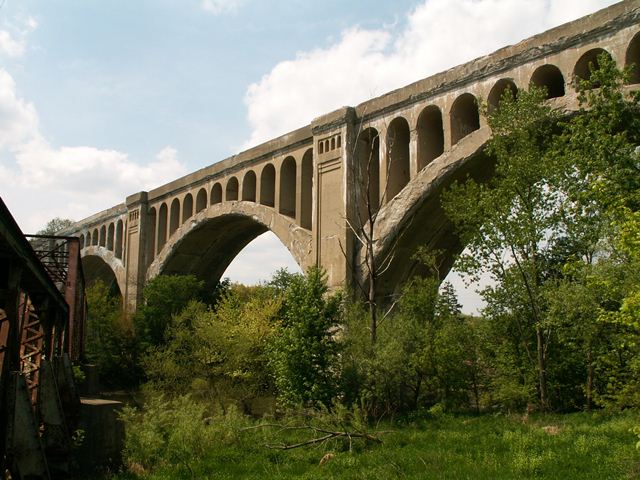We Recommend:
Bach Steel - Experts at historic truss bridge restoration.
BridgeHunter.com Phase 1 is released to the public! - Visit Now
Big Four Bridge

Primary Photographer(s): Nathan Holth
Bridge Documented: May 5, 2006
Railroad (CSX) Over Great Miami River, Main Avenue, and Childrens Home Road (CR-41)
Sidney: Shelby County, Ohio: United States
Not Available or Not Applicable
140.0 Feet (42.7 Meters)
780.0 Feet (237.7 Meters)
29 Feet (8.84 Meters)
5 Main Span(s)
Not Applicable

View Information About HSR Ratings
Bridge Documentation
View A Historical Article Discussing Construction of This Bridge
The informative sign near this bridge mentioned that the bridge was built as a relocation project after a devastating flood in 1913 that apparently wiped out the downtown bridge. Perhaps the stone piers visible next to the North Street Bridge are the remains of this former bridge?
This bridge has a date cast into on a pier showing a 1923 construction date, but an informative plaque mounted near the bridge says it was opened in 1924. The sign also notes that five men died building this bridge. Particularly interesting, is that one of those workers is apparently still buried in the pier east of Main Avenue. Not a lot of OSHA safety going in the 1920s! Similar horror stories about people being buried in the concrete of the bridge have surfaced with other large concrete bridges like this one, and some of those stories appear to be more myth than truth. The validity of the buried person in this bridge is not known.
The fact that people died building this bridge is an example of why a bridge like this should be preserved. Maintaining and restoring a bridge such as this one honors the people who gave their lives to keep our country's road and rail networks connected and functioning. Beyond that, this bridge should be preserved because it is such an awesome bridge, and a landmark for Sidney. Unfortunately, this is not the case. Although the bridge appears to continue to serve railroad traffic, and is likely structurally sound given how massive it is, horrendous spalling of the concrete has occurred on the arch and this is reducing the bridge's beauty by slowly destroying the architectural details of this bridge.
This bridge is great for photographing, as there is a beautiful multi-span metal truss bridge next to this bridge. You can get excellent photos of the bridge with the truss bridge in the foreground. Like the Big Four Bridge however, this truss bridge is not being maintained (it is abandoned) and so it cannot be guaranteed that this bridge combination will remain forever.
![]()
Photo Galleries and Videos: Big Four Bridge
Bridge Photo-Documentation
Original / Full Size PhotosA collection of overview and detail photos. This gallery offers photos in the highest available resolution and file size in a touch-friendly popup viewer.
Alternatively, Browse Without Using Viewer
![]()
Bridge Photo-Documentation
Mobile Optimized PhotosA collection of overview and detail photos. This gallery features data-friendly, fast-loading photos in a touch-friendly popup viewer.
Alternatively, Browse Without Using Viewer
![]()
Maps and Links: Big Four Bridge
Coordinates (Latitude, Longitude):
Search For Additional Bridge Listings:
Bridgehunter.com: View listed bridges within 0.5 miles (0.8 kilometers) of this bridge.
Bridgehunter.com: View listed bridges within 10 miles (16 kilometers) of this bridge.
Additional Maps:
Google Streetview (If Available)
GeoHack (Additional Links and Coordinates)
Apple Maps (Via DuckDuckGo Search)
Apple Maps (Apple devices only)
Android: Open Location In Your Map or GPS App
Flickr Gallery (Find Nearby Photos)
Wikimedia Commons (Find Nearby Photos)
Directions Via Sygic For Android
Directions Via Sygic For iOS and Android Dolphin Browser
USGS National Map (United States Only)
Historical USGS Topo Maps (United States Only)
Historic Aerials (United States Only)
CalTopo Maps (United States Only)




